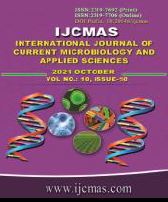


 National Academy of Agricultural Sciences (NAAS)
National Academy of Agricultural Sciences (NAAS)

|
PRINT ISSN : 2319-7692
Online ISSN : 2319-7706 Issues : 12 per year Publisher : Excellent Publishers Email : editorijcmas@gmail.com / submit@ijcmas.com Editor-in-chief: Dr.M.Prakash Index Copernicus ICV 2018: 95.39 NAAS RATING 2020: 5.38 |
Sesame (Sesamum indicum L.) plays a vital role in the Indian agriculture, industry and export trade. It commonly known as til and also called as “queen of oilseeds” has been known to be one of the earliest domesticated edible oilseeds used by mankind. It is grown in wide range of environments extending from semi-arid tropics and subtropics to temperate regions. A field experiment entitled “effects of irrigation and nutrient management on summer sesame (Sesamum indicum L.)”,was conducted at the Agricultural Research Station, Brinjhagiri, Chatabar of Faculty of Agricultural Sciences, Siksha ‘O’ Anusandhan (Deemed to be University), Bhubaneswar (Odisha) during summer season of 2021. Treatments included three irrigation levels (I1: 2 irrigations at 21 and 63 days after sowing, I2: 2 irrigations at 21 and 42 days after sowingand I3: 3 irrigations at 21, 42 and 63 days after sowing) are treated in main plot and four nutrient management (N1: 100% RDF, N2: 100% RDF + 2 t/ha FYM, N3: 100% RDF + 2 t/ha FYM + Jeevamrut @250l/ha and N4: 75% RDF + 2 t/ha FYM + Jeevamrut @250l/ha) are treated in sub plot were experimented in split plot design replicate thrice. The experiment was conducted with the variety of TKG-21 followed the spacing of 30 cm × 10 cm. The experimental soil was sandy loam in texture with the pH of 5.65 and EC of 7.33 ds/m. The recommended dose of NPK was given 30:15:15 kg ha-1. From the experiment, highest seed yield (643.49 kg ha-1), haulm yield (1820.13 kg ha-1) and harvest index (26.04%) was obtained in I3. N4 (75% RDF + 2 t/ha FYM + Jeevamrut @250l/ha) showed second highest seed yield (652.21 kg ha-1), haulm yield (1882.07 kg ha-1) and harvest index (25.74%) which is at per with N3. Highest water use efficiency (2.72 kg ha-1 m-1) was calculated in I2N3. Hence, it can be conclude that cultivation of sesame under75% RDF + 2 t/ha FYM + Jeevamrut @250l/ha with 2 irrigations at 21 and 42 days after sowing proved better in terms of yield, economics and water use efficiency.
 |
 |
 |
 |
 |